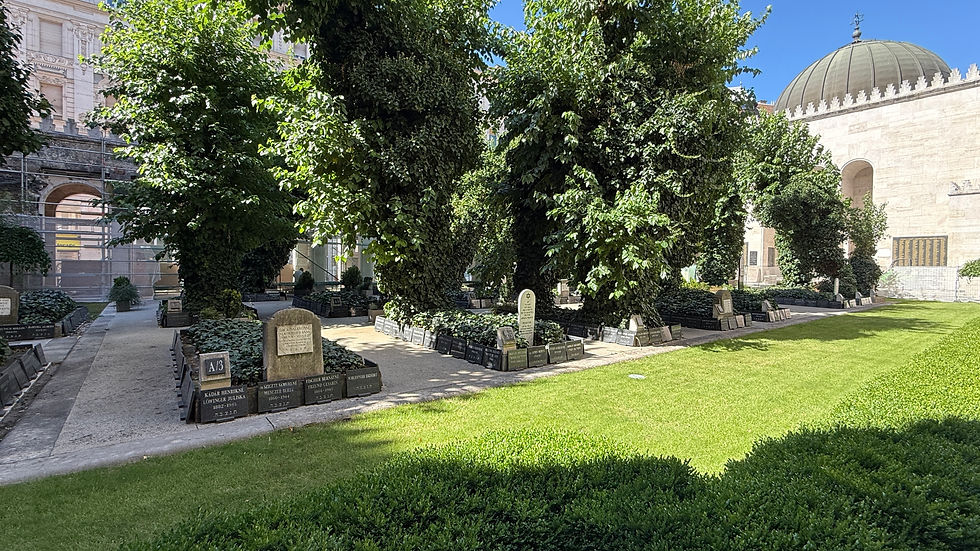The Courtyard That Became a Cemetery, Budapest’s Dohány Street Synagogue and an Extraordinary Exception
- Brad Kaplan
- Oct 14
- 3 min read
When a Synagogue Became a Sanctuary for the Dead
If you’ve toured the Jewish Quarter in Budapest, you know the Great (Dohány Street) Synagogue dazzles with Moorish-style architecture and soaring arches. What most visitors don’t expect is what lies just behind it — a courtyard that doubles as a cemetery.

Under normal circumstances, Jewish law forbids burials beside a synagogue. Jewish cemeteries are not located near churches because Jewish tradition and law prioritize separating Jewish burial grounds from non-Jewish holy spaces, reflecting a distinct religious and cultural identity. While Christian graveyards were historically often located on church grounds, Jewish cemeteries are managed separately and are not connected to any particular church, allowing for the application of Jewish burial laws and practices.
But the winter of 1944–45 was anything but normal. During the Nazi occupation and the creation of the Budapest Ghetto, thousands of Jews perished within its walls. With access to cemeteries cut off and the city under siege, the community sought special permission to bury the victims in the synagogue’s courtyard — transforming a sacred space of worship into one of remembrance.
The Ghetto Winter of 1944–45

By December 1944, the Pest Ghetto had been sealed. Starvation, cold, and disease spread rapidly among the tens of thousands trapped inside. As death tolls rose daily, there was simply nowhere to take the bodies for burial.
In desperation, religious leaders appealed for an emergency halachic ruling — allowing temporary burials within the courtyard. After liberation by Soviet forces on January 18, 1945, the community recorded approximately 2,000–2,300 victims laid to rest beside the synagogue.
What began as a wartime necessity became a permanent memorial — a solemn reminder of faith, loss, and the resilience of those who endured.
A Rare Exception to Sacred Tradition
Ordinarily, Jewish tradition demands that burial grounds be located outside city limits, never adjoining a synagogue. This separation reflects the distinction between life (symbolized by prayer) and death (honored through remembrance).
Yet the Dohány courtyard remains an extraordinary exception — one recognized and preserved out of reverence for the victims. Each grave and plaque tells a story of humanity’s endurance under impossible conditions.
Raoul Wallenberg Memorial Park and the Tree of Life
Just beyond the courtyard stands Raoul Wallenberg Holocaust Memorial Park, home to the “Tree of Life” sculpture by artist Imre Varga. Its weeping branches of steel bear thousands of engraved leaves — each inscribed with the name of a Holocaust victim or family.
The sculpture’s inverted-menorah design symbolizes both grief and the persistence of memory. It also honors diplomats like Wallenberg, Carl Lutz, and Ángel Sanz Briz — who risked everything to save Hungarian Jews during the Holocaust.
Visiting the Site Today
Respectful Reflection: The courtyard cemetery is a place of silence. Photography may be restricted, and modest dress is appreciated.
Memorial Context: The site forms part of the Dohány Street Synagogue complex, which includes the Jewish Museum and Heroes’ Temple.
Meaning in Memory: Each marker, plaque, and leaf represents both loss and legacy — the continuation of remembrance across generations.
When you visit, take a moment to stand quietly in the garden. The stillness speaks volumes.
Why This Story Matters?

For travelers, the Dohány Street Synagogue may appear on a “must-see” list for its architecture — but its courtyard cemetery reveals the human story beneath the stones. It is both a spiritual and historical landmark, preserving the voices of those who could not leave the ghetto.
It reminds us that travel isn’t just about places; it’s about people, choices, and memories. As you wander Budapest’s lively streets today, this hidden courtyard whispers a simple truth: remembrance is its own form of resistance.
EMRJ Travel Insight: When exploring Europe’s Jewish heritage sites — from Prague’s Old Jewish Cemetery to Kraków’s Kazimierz district — remember that each carries centuries of faith, tragedy, and renewal. Travel with empathy; listen with intention.



Comments